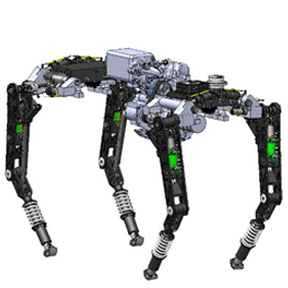Compared to humans and animals, however, the mobility and manipulations capability of robots currently in service is poor. If these limitations were overcome, robots could much more effectively assist warfighters and other DoD personnel across a greater range of missions. DARPA’s Maximum Mobility and Manipulation (M3) program seeks to create and demonstrate significant scientific and engineering advances in robot mobility and manipulation capability. If successful, M3 will significantly improve robot capabilities through new approaches to engineering better design tools, fabrication methods and control algorithms. M3 expected to reach its final review stage by 2014.
M3 consists of four parallel tracks:
Track 1, Design tools: To develop tools that enable prototypes to be built with predicted mobility and manipulation performance, DARPA has contracted with Carnegie Mellon University, Jet Propulsion Laboratory, University of California Santa Cruz, Raytheon and Vecna Technologies.
Track 2, Fabrication methodologies. To develop printing and self-assembly processes that require substantially less time and expense to assemble robot components than present methods, DARPA has contracted with Cornell, Harvard and Tufts Universities, and University of California, Berkeley.
Track 3, Control methods: To develop and demonstrate intermediate-level controls for mobility and manipulation, including environment-based dynamic gait selection, dynamic gait and body mass modulation, and dynamic stability control, DARPA has contracted Carnegie Mellon and Case Western Reserve Universities, Georgia Tech Research Institute, iRobot, Massachusetts Institute of Technology, Tekrona, and University of California at Santa Barbara.
Track 4, Technology demonstration prototypes: To design and construct technology prototype robots and subsystems to spur innovation in the above areas, DARPA has contracted with Boston Dynamics, Carnegie Mellon University, HRL, iRobot, Massachusetts Institute of Technology, Oregon State University, Other Lab and the University of Florida’s Institute of Human and Machine Cognition.
‘Initially M3’s control efforts will focus on approaches using augmented teleoperation, also known as supervised autonomy. Thus, concepts with primary application to full autonomy, cognition, reasoning, high-level decision-making, high-level decision-making under uncertainty, and other higher-level cognitive functions are envisioned as a potential later addition to the M3 programme,’ said DARPA.
Autonomous Robotic Manipulation
Darpa Autonomous Robotic Manipulation will create manipulators with a high degree of autonomy capable of serving multiple military purposes across a wide variety of application domains, including but not limited to counter-IED, countermine, search and rescue, weapons support, checkpoint and access control, explosive ordnance disposal, and combat casualty care (including battlefield extraction and treatment). ARM will enable autonomous manipulation systems to surpass the performance level of remote manipulation systems that are controlled directly by a human operator.
If you liked this article, please give it a quick review on ycombinator or StumbleUpon. Thanks

Brian Wang is a Futurist Thought Leader and a popular Science blogger with 1 million readers per month. His blog Nextbigfuture.com is ranked #1 Science News Blog. It covers many disruptive technology and trends including Space, Robotics, Artificial Intelligence, Medicine, Anti-aging Biotechnology, and Nanotechnology.
Known for identifying cutting edge technologies, he is currently a Co-Founder of a startup and fundraiser for high potential early-stage companies. He is the Head of Research for Allocations for deep technology investments and an Angel Investor at Space Angels.
A frequent speaker at corporations, he has been a TEDx speaker, a Singularity University speaker and guest at numerous interviews for radio and podcasts. He is open to public speaking and advising engagements.


